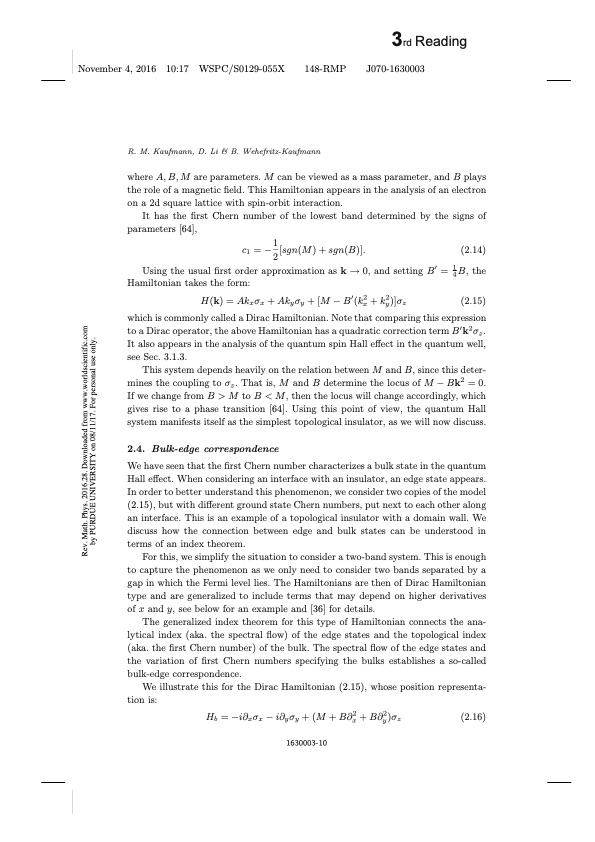
PDF Publication Title:
Text from PDF Page: 010
R. M. Kaufmann, D. Li & B. Wehefritz-Kaufmann where A, B, M are parameters. M can be viewed as a mass parameter, and B plays the role of a magnetic field. This Hamiltonian appears in the analysis of an electron on a 2d square lattice with spin-orbit interaction. It has the first Chern number of the lowest band determined by the signs of parameters [64], c1 =−1[sgn(M)+sgn(B)]. (2.14) 2 Using the usual first order approximation as k → 0, and setting B′ = 1 B, the 4 Hamiltonian takes the form: H(k) = Akxσx + Akyσy + [M − B′(kx2 + ky2)]σz (2.15) which is commonly called a Dirac Hamiltonian. Note that comparing this expression to a Dirac operator, the above Hamiltonian has a quadratic correction term B′k2σz. It also appears in the analysis of the quantum spin Hall effect in the quantum well, see Sec. 3.1.3. This system depends heavily on the relation between M and B, since this deter- mines the coupling to σz. That is, M and B determine the locus of M −Bk2 = 0. If we change from B > M to B < M, then the locus will change accordingly, which gives rise to a phase transition [64]. Using this point of view, the quantum Hall system manifests itself as the simplest topological insulator, as we will now discuss. 2.4. Bulk-edge correspondence We have seen that the first Chern number characterizes a bulk state in the quantum Hall effect. When considering an interface with an insulator, an edge state appears. In order to better understand this phenomenon, we consider two copies of the model (2.15), but with different ground state Chern numbers, put next to each other along an interface. This is an example of a topological insulator with a domain wall. We discuss how the connection between edge and bulk states can be understood in terms of an index theorem. For this, we simplify the situation to consider a two-band system. This is enough to capture the phenomenon as we only need to consider two bands separated by a gap in which the Fermi level lies. The Hamiltonians are then of Dirac Hamiltonian type and are generalized to include terms that may depend on higher derivatives of x and y, see below for an example and [36] for details. The generalized index theorem for this type of Hamiltonian connects the ana- lytical index (aka. the spectral flow) of the edge states and the topological index (aka. the first Chern number) of the bulk. The spectral flow of the edge states and the variation of first Chern numbers specifying the bulks establishes a so-called bulk-edge correspondence. We illustrate this for the Dirac Hamiltonian (2.15), whose position representa- tion is: H b = − i ∂ x σ x − i ∂ y σ y + ( M + B ∂ x2 + B ∂ y2 ) σ z ( 2 . 1 6 ) 1630003-10 Rev. Math. Phys. 2016.28. Downloaded from www.worldscientific.com by PURDUE UNIVERSITY on 08/11/17. For personal use only.PDF Image | Notes on topological insulators

PDF Search Title:
Notes on topological insulatorsOriginal File Name Searched:
RMP.pdfDIY PDF Search: Google It | Yahoo | Bing
Sulfur Deposition on Carbon Nanofibers using Supercritical CO2 Sulfur Deposition on Carbon Nanofibers using Supercritical CO2. Gamma sulfur also known as mother of pearl sulfur and nacreous sulfur... More Info
CO2 Organic Rankine Cycle Experimenter Platform The supercritical CO2 phase change system is both a heat pump and organic rankine cycle which can be used for those purposes and as a supercritical extractor for advanced subcritical and supercritical extraction technology. Uses include producing nanoparticles, precious metal CO2 extraction, lithium battery recycling, and other applications... More Info
| CONTACT TEL: 608-238-6001 Email: greg@infinityturbine.com | RSS | AMP |